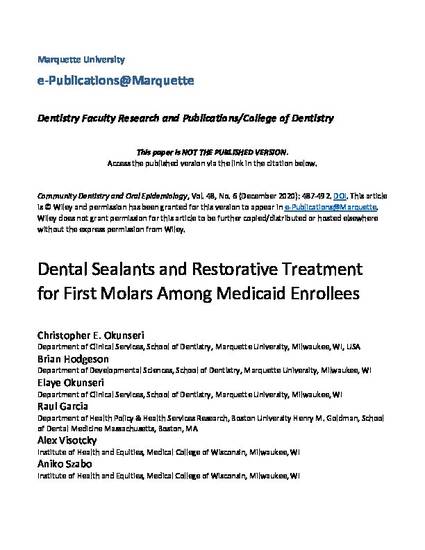
Objectives
To assess the association between dental sealant placement and subsequent restorative treatment of permanent first molars over time. Methods
We analysed Wisconsin Medicaid claims data from 2001 to 2009 for children aged 6-16 years. Children entered the study cohort at age 6 and were censored if Medicaid eligibility was lost for >31 days. A fixed effects analysis via a Cox proportional hazards model, stratified by individual, was used to estimate the time-averaged and time-dependent effects of sealant placement on dental treatment defined as any restorative, endodontic or surgical procedure. Results
A total of 185,262 children with permanent first molars who turned 6 years enrolled in Medicaid were examined. Sealant placement was higher for teeth #16 and 26 (5.42 and 5.46 per 100 person-years (100PY), versus 5.29 and 5.31/100PY for #36 and 46, respectively. The average rate for restorative treatments had the opposite pattern, with lower rate for teeth #16 and 26 (1.78 and 1.72/100PY) versus teeth #36 and 46 (2.14 and 2.12/100PY), respectively. In the fixed effects regression model, the hazard of dental treatment was substantially lower after sealant placement on a tooth, with time-averaged hazard ratio HR = 0.23 (95% CI 0.21-0.25, P < .001) versus before sealant. The largest effect was in the first year after sealant placement (HR = 0.13, 95% CI: 0.11-0.14), which decreased over time (HR = 0.50, 0.59 and 0.74 in years 2, 3 and 4, respectively), and was not statistically significant in later years. Conclusions
This study demonstrates that permanent first molar sealant placement delayed subsequent dental treatments in children enrolled in Medicaid.
Available at: http://works.bepress.com/brian_hodgson/21/
Accepted version. Community Dentistry and Oral Epidemiology, Vol. 48, No. 6 (December 2020): 487-492. DOI. © 2020 Wiley. Used with permission.